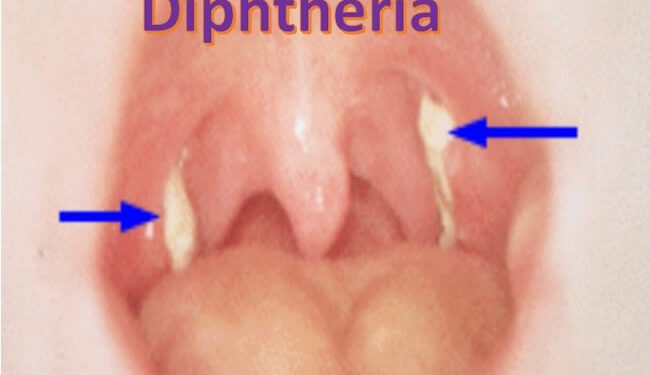Diphtheria is a serious infection caused by strains of bacteria called Corynebacterium diphtheria that makes toxin. It can lead to difficulty breathing, heart rhythm problems, and even death. Vaccines are normally recommended for infants, children, teens, and adults to prevent diphtheria. The bacterium releases a toxin that causes a buildup of grey tissue in your throat, leading to problems with swallowing and breathing. In warmer climates, someone with diphtheria might also develop skin sores that will not heal and may be covered with the grey tissue. In many areas of the world, diphtheria is still considered an endemic (an outbreak that’s limited to a certain region). This includes Asia, the Dominican Republic, Eastern Europe, Haiti, the South Pacific and the Middle East. You can catch diphtheria through airborne droplets that contain bacteria (spread by sneezing, coughing and spitting) or by touching something that has bacteria on it. It is also possible that an infected person could transmit the disease through an open sore touched by someone else, or touching clothes that someone else touches. It’s possible to get diphtheria more than once. Who’s at risk of developing diphtheria? Anyone who isn’t protected by the vaccine and comes in close contact with an infected person can develop diphtheria.
Symptoms and Causes; Throat pain. Weakness or fatigue, fever, and swollen neck glands. Problems breathing due to tissues obstructing your nose and throat. Difficulty with swallowing (dysphagia), Nerve, Kidney or Heart problems (if the bacteria enters your bloodstream). An infected person typically shows signs of diphtheria around two to five days after exposure. The length of time for symptoms to show can be anywhere from one to 10 days after exposure. What causes diphtheria? Diphtheria is caused by bacteria adhering to the lining of your respiratory system. These bacteria generate a toxin that damages your respiratory tissue cells. Within two or three days, the tissue left behind forms a bulky, grey coating. This coating has the potential to cover tissues in your voice box, throat, nose and tonsils. For the infected person, breathing and swallowing become hard to do. Is diphtheria contagious? Yes. Diphtheria is a highly contagious disease that’s spread through airborne droplets or contaminated personal items. Diagnosis and Tests How is diphtheria treated? Diphtheria treatment begins immediately — sometimes even before the lab test results are confirmed. There are many different vaccines that are designed to stop diphtheria. Several of them protect you against multiple infections at once, such as pertussis (whooping cough) and tetanus as well as diphtheria. There are different immunization schedules for getting the series of shots, including booster shots after the first ones are given. In general, vaccine side effects might include fever, pain or redness at the needle site, and rarely, an allergic reaction to the vaccine itself.
Treatment for diphtheria can be effective. But, even with treatment, roughly 1 out of 10 people might die. For those without treatment, one out of two patients may die. Vaccination is the best choice.





